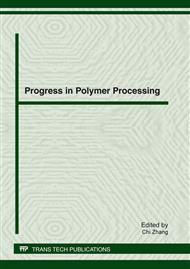p.99
p.104
p.108
p.114
p.117
p.122
p.128
p.134
p.139
Analysis of Influences of Processing Parameters on Filling Behavior in Microinjection Molding with a Hot Runner Nozzle
Abstract:
The ability for polymer melt to flow into the microstructure is a crucial factor for successful molding in the microinjection molding of plastic parts. In this study, a simplified analytical model with a direct hot runner nozzle and was constructed to estimate the filling percentage of mold’s cavity. The filling behavior of polymer melt was observed by 3D simulation software Moldflow. The effects of the mold temperature, melt temperature, injection pressure, injection rate, and packing pressure on the filling behavior of polymer melt were investigated. Results revealed that the filling percentage increased with respect to the increase of mold temperature and melt temperature which didn’t exceed its degradation temperature. The injection pressure and packing pressure dramatically influence the filling percentage, and it made no sense to lift the injection speed to fill the cavity when the injection speed reached the relatively high values, and only processing parameter combined available could guarantee the perfect flow and filling for the microstructure.
Info:
Periodical:
Pages:
117-121
Citation:
Online since:
January 2012
Authors:
Keywords:
Price:
Сopyright:
© 2012 Trans Tech Publications Ltd. All Rights Reserved
Share:
Citation:


